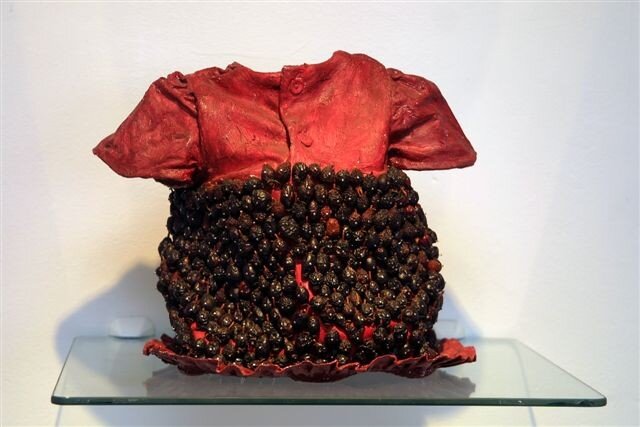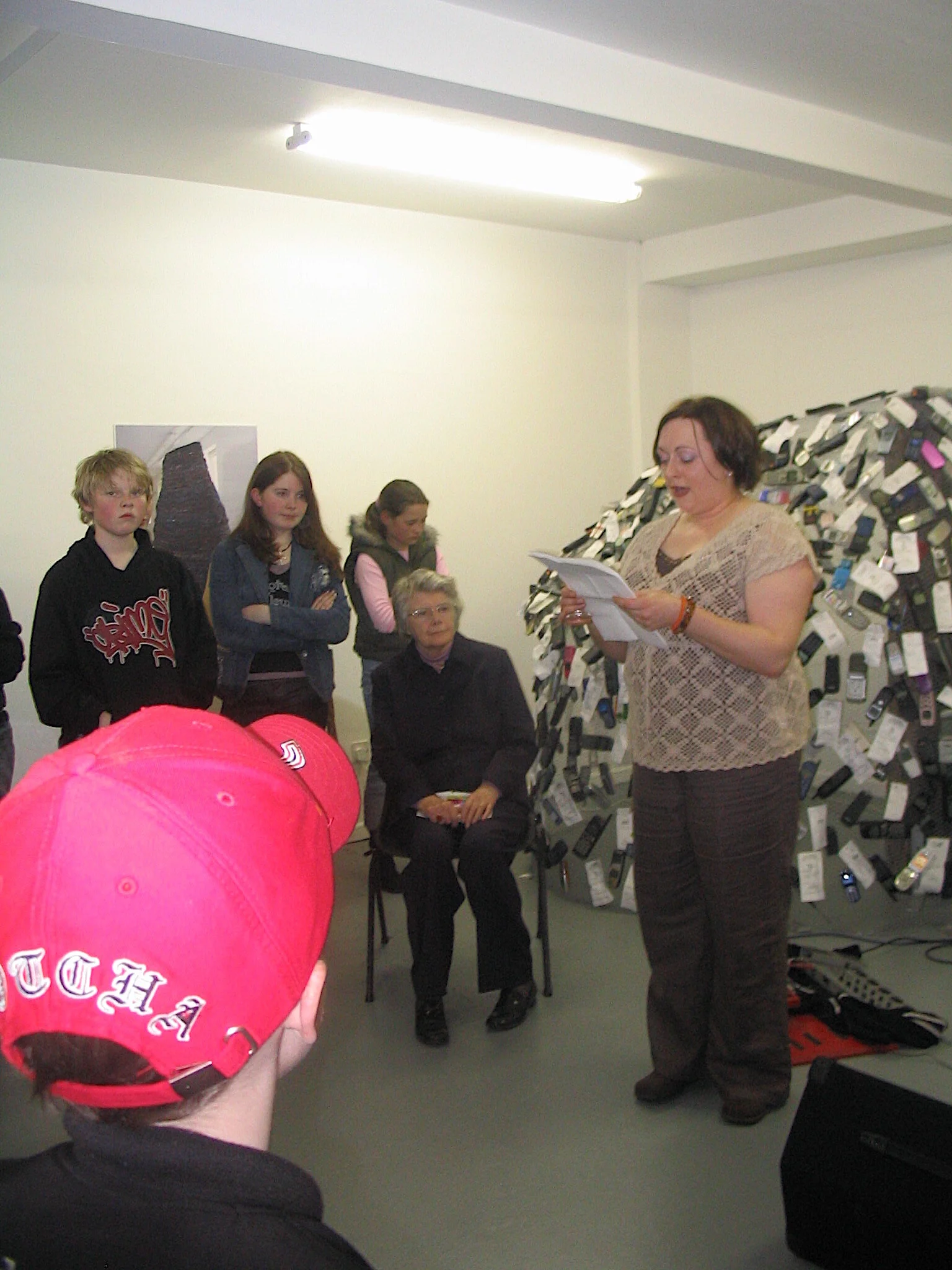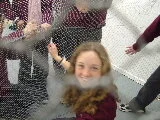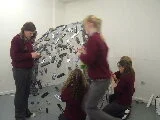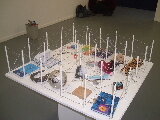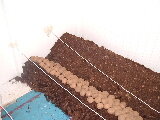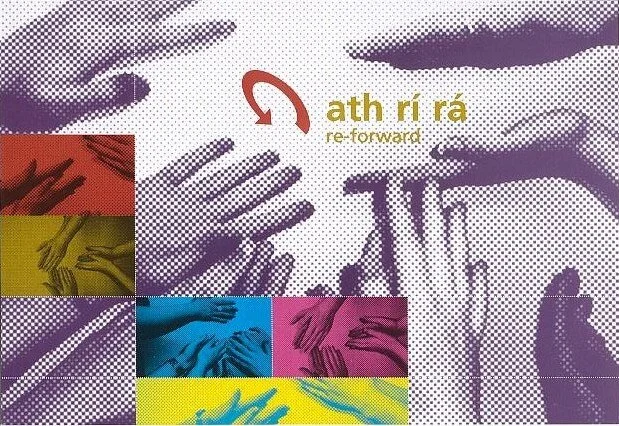Ath Rí Rá

Ath Rí Rá
Is léir go bhfuil spiorad agus aidhmeanna rannpháirteachais an Chláír Náisiúnta, a bunaíodh sa bhliain 1997 chun dáileadh a dhéanamh ar acmhainní IMMA agus a bhailiúchán a chur chun tosaigh, curtha i bhfeidhm sa taispeántas Ath Rí Rá. Is grúpa ina bhfuil 20 dalta idirbhliana, atá sna mic léinn ó Phobailscoil Cloich Cheannfhaola.
Rinneadh an tionscadal a dhearadh mar mhodh do na mic léinn a scileanna pearsanta a threisiú agus a fhorbairt agus ag an am chéanna a bheith ag comhoibriú lena gcomhghleacaithe ranga ar dhóigh éifeachtach thorthúil. Tá sárobair déanta ag an ghrúpa, i bhfad níos mó ná bhíothas ag dréim uatha, ag dul i gceann an tionscadail le fuinneamh agus spionnadh a d’fhéadfadh dúshlán a thabhairt d’aon choimeadaí ealaíne nó ealaíontóir gairmiúil.
Tá dhá eilimint ag baint leis an tionscadal seo. Bhí sé mar aidhm ag an chéad cheann na mic léinn a dhéanamh eolach ar dhearcealaín chomhaimseartha agus ar ionaid taispeántais. Cuireadh é seo i gcrích trí chaidreamh a bhunú le IMMA agus deis a thabhairt do na mic léinn taiscéaladh a dhéanamh ar a bhailiúchán náisiúnta. I ndiaidh a gcuairte ar IMMA, thosaigh na mic léinn ag scrúdú an bhailiúcháin agus roghnaigh siad dornán píosaí le cur ar taispeántas i nDún na nGall. Maidir leis an dara heilimint, a bhfuil suntas faoi leith i gceist léi, roghnaigh na mic léinn roinnt saothar a ndéanfadh siad féin ‘athléamh’ orthu de réir critéir a bheadh comhaontaithe roimh ré.
Fá choinne an dara heilimint den tionscadal, phioc na mic léinn saothair áirithe a ndéanfadh siad féin athmhúnlú orthu. Bhí na roghanna seo bunaithe go hiomlán ar an dóigh ina ndeachaigh na saothair sin i gcion orthu féin nuair a chonaic siad i dtús báire iad, gan léitheoireachta ar bith déanta acu ar a gcúlra roimh ré. Agus iad ag déanamh athoibriú nó athléamh ar na píosaí, chuir siad na trí critéir seo a leanas i bhfeidhm: 1 – Tá mé 16 bliain d’aois. 2 – Seo an bhliain 2005. 3 – Tá mé i mo chónaí i gceantar tuaithe in Éirinn.
I ndáiríre, tá fíorthábhacht ag baint le hiarmhairt charnach an tionscadail seo. Thosaigh 20 mac léinn a ndéanamh féin eolach ar ghnéithe de dhearcealaín chomhaimseartha agus d’ionaid taispeántais, agus a bhuíochas don phróiseas tionscadail ar baineadh úsáid as, tá bailíocht tugtha acu do bharúlacha agus athléamh s’acusan. Le linn an phróisis chumasaithe seo go léir, mhéadaigh muinín na mac léinn ina mbarúlacha féin go mór, ó thaobh inchloisteachta agus infheictheachta araon, mar a léiríonn Ath Rí Rá.
Fáiltíonn IMMA roimh an deis dhúshlánach seo ina gcuirtear ceastóireacht orthu faoi cad atá i gceist le healaín a chur ar taispeántas don phobal. Fhad is a bhí Ath Rí Rá ar siúl, thaitin sé go mór leis an músaem glacadh leis an dúshlán agus na fiafraitheachta nuálaí ó leithéid de ghrúpa mac léinn chomh díograiseach sin. Is de bharr na tacaíochta carthanaí a fuarthas ó Údarás na Gaeltachta a bhíothas in ann an tionscadal seo a chur i gcrích.
Johanne Mullan - IMMA
Ath Rí Rá
Ath Rí Rá is the culmination of a collaboration involving the National Programme, Irish Museum of Modern Art (IMMA), Ceardlann na gCroisbhealach and the Transition Year students and staff of Pobailscoil Cloich Cheannfhaola. This exhibition, selected from the IMMA Collection by the students, represents a celebration of a creative and richly collaborative process for all partners.
Ath Rí Rá embodies the spirit and participative objectives of the National Programme, which was established in 1997 to distribute the resources of the IMMA and to promote its collection. The students from Pobailscoil Cloich Cheannfhaola are a group of 20 transition year students.
The project was designed as an outlet for the students to increase and develop their individual abilities while collaborating with their classmates in a constructive and productive way. The group have worked above and beyond any expectation, approaching the project with a vigour and freshness which could challenge any professional curator or artist.
There are two elements to this project the first was to introduce the students to contemporary visual art and exhibition venues. This was carried out by establishing a relationship with IMMA and the opportunity to explore its national collection. After visiting IMMA the students set about examining the collection and selected a number of pieces to exhibit in Donegal. Secondly, and of particular interest, the students identified a number of works that they would ‘re-interpret’ based on an agreed criteria.
The artworks selected for exhibiting include The Gate by Deborah Brown which draws on two sources of inspiration, both dealing with human freedom. The scenarios on the left side of The Gate, were suggested by Mahler's cycle Des Knaben Wonderhorn. A man is imprisoned in his cell but his thoughts are free. He is depicted sitting within an open grid box. In his thoughts he goes up into the mountains and knocks on the door of his lover, who is symbolised by an open door frame. On the right side, the scenarios have been suggested by the Irish legend of the Merrow, which tells the story of a fisherman called Jack and his encounter with a Merrow, or man of the sea. Jack befriends the Merrow, called Coomarra and goes with him to the bottom of the sea where Coomarra shows him the room where he keeps the souls of drowned sailors in his "soul cages". Jack contrives and succeeds in setting the souls free.
Willie Doherty’s work Lamenting / Longing was also selected and is concerned with the way images disseminated through mass media manipulate our interpretations of events and people, particularly in the construction of notions of ethnic or national identity. Doherty’s themes and subjects are drawn from his own local experience of Derry and his practice does not so much seek to present a more authentic representation of the political landscape, but is an examination and a critique of the "question of authenticity".
Tipperary born Alice Maher, works with materials like bees, berries and hair she builds up a strong relationship with their histories and cultural associations in the creation of surreal works that appear like enchanted objects from a medieval folk tale. The students selected the work Berry Dress that presents the delicate shape of the child's dress, decorated with ripe berries. On closer inspection, the dress loses its innocence, taking on a more sinister appeal. The pins, which hold the berries in place, are arranged internally: should the dress be worn, these pins would pierce the skin.
In the second element of the project the students selected a number of works that they would re-work. The selection was based soley on their immediate response with no background reading on the art piece. The criteria they employed to re-work or re-interpret the piece was threefold; 1 – I am 16 yrs old. 2 – This is 2005. 3 – I live in rural Ireland.
Kathy Prendergast’s Stack was an instant choice. The students understanding the economic element to the work translated this to the ‘youth economy’ of mobile phones and communication. Hundreds of redundant mobile phones, call payment slips and chewing gum have been used in this work.
Berry Dress by Alice Maher was also of great interest to the students. Even though they felt repelled and intrigued at the same time, there was a clear ambiguity. In response to this the students have collected hundreds of health/sexuality questions from the problem pages of teenage magazines – not the answers. These scraps have been joined together to make up a skirt and a shirt, both suspended on a large wire question mark.
During the visit to IMMA all the students responded favourably to Neon Rice Field by Vong Phaophanit. They were seriously seduced by it yet eventually read the underlying world hunger theme. In translating this work to their own criteria the students have utilised alternate rows of turf and potatoes topped with peat briquettes and crisps.
The Head series of Enrico Baj has allowed the students to present collage self portraits. Finally, Gate by Deborah Brown was selected because the students identified the ‘path to freedom’ narrative. Sensing the appropriateness of this theme to their immediate scholastic context the students have re-worked this piece to represent 20 of their own career aspirations. Similar to the original work it is a hopeful and optimistic piece. The cumulative outcome of this project is indeed very important. 20 students began by familiarising themselves with aspects of contemporary visual art and exhibition venues and, through the project process employed, they have given validity to their opinions and interpretations. Throughout this empowering process the student’s confidence in their own opinions has grown both audibly and visually as evidenced by Ath Rí Rá.
IMMA welcomes the opportunity to be challenged and questioned about what it means to put art on show for the public. During Ath Rí Rá it has been thoroughly refreshing for the museum to be challenged and questioned by such an enthusiastic group of students. This project was made possible with the kind support of Údarás na Gaeltachta.
